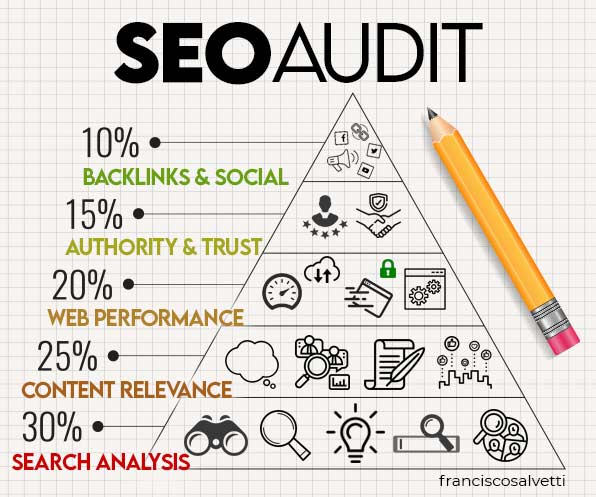An SEO audit is a recommended practice that should be carried out before starting a search marketing campaign and again once it is running. Performing an SEO audit allows business owners to find the strengths and weaknesses of their current SEO strategy to improve their website’s organic rankings.
A comprehensive SEO audit evaluates several areas of interest such as crawling or indexing errors, broken links, redirects, traffic channels, content quality, page load time, user experience, etc.
Things to look for in an SEO audit
I made this infographic to emphasize not the order but the importance of each step. The SEO audit can be done in any order of steps but the most important aspects are those that make the base of the pyramid in the SEO plan: Proper search analysis and high-quality content that is relevant to the audience.

The SEO Audit pyramid in 2022
\
There are more than 200 factors that Google takes into account to rank websites. Most of the time, we are working either on-page or off-page.
-
On-page includes technical SEO aspects (indexability, crawling, performance, crawler directives, etc.) and content (web architecture, UX, headings, keywords, internal links, etc.)
-
Off-page relies on external sites and their relationship to the website (social media signals, inbound links, authority, local and offline presence, etc.).
Here’s a checklist with the most essential things to consider during an SEO audit:
SEO audit checklist
1. Indexability ✔️
First we check what pages are currently being indexed by search engines. A good starting point is Google’s own tool: Search Console.
After setting up the domain property and URL, the Coverage report will show us all indexed URLs and the ones with indexing errors.
Another way to see the indexed URLs of a site is through the command site:domain.com in the Google search bar.
Although not all URLs may appear there, it will give us a general picture of how many occurrences our website or web application returns.
Common errors with crawling and indexability can be fixed by analyzing or creating a robots.txt file and making sure that no directories or URLs are blocked. Likewise, we should check that the sitemap.xml file has been properly set up. This file or files specify the architecture of our website, making it possible for search engine crawlers to find HTTP errors such as 3xx, 4xx and 5xx, which we’ll be notified via the Search Console or other tools.
Read also: How to get the green padlock of SSL certification on my website?
2. Web architecture ✔️
A website with an inadequate information architecture can have a negative impact in other ranking factors, such as user experience.
Click-through levels should be evaluated during this SEO audit process. This is done by counting the different levels of depth that are required to reach a specific page, starting from the home or index page (level 0). The goal is to reduce the number of levels that the website has.
Other items to analyze in this step include: navigation menus, content hierarchy (categories or subfolder), subdomain usage, URL length and readability, pagination issues, design consistency, and use of breadcrumbs.
3. Usability and performance ✔️
This step involves making sure there aren’t any broken links (internal or external) in the website. Ahrefs offers a reliable and secure online tool that checks for broken links for free.
404 errors are the main source of bad user experiences on the web. The solution is to replace each broken link with an active link. In the case of external links, if we can’t find a reliable site that will guarantee long-term activity, we can remove the link tag.
During this step of the audit, we can also check how the website performs when accessed from different types of devices and operating systems. We verify that the website is fully responsive or we make the proper adjustments via CSS.
Another important aspect is page load speed. This is a direct ranking factor and will affect SEO because it’s closely related to user experience. Read more here: How to improve page load speed on your website
4. Content quality ✔️
Quality content usually means relevant content. This is usually one of the most complex and extensive parts of an SEO audit because in many cases it is the content — not the website — that connects the business to its audience.
To begin, we look for thin content and determine its usefulness before removing it. Thin content is that which has little or no value to the user, including duplicate, unoriginal, spammy, or irrelevant content.
This type of content should be removed as not to decrease the quality of the website and because it can hurt our crawl budget: Googlebot has a crawl capacity limit for each website which should not be wasted.
Next, we assess the titles of individual pages, also known as the H1 tags, starting from level 0 (homepage) to make them relevant and consistent with the goals of our search analysis. This will include adding specific keywords and several rounds of A/B testing to find the words that will grab more attention and perform well in the SERPs (search engine results pages).
Just as important as titles are subtitles. We will check the subheadings for keyword usage and relevance, based on proper search analysis. If the site doesn’t have any relevant content, it’s time to plan a content strategy.
5. Optimizing images for SEO ✔️
Images can have a big impact on web rankings, especially in niches that are visually-driven. During this phase of the SEO audit, we will check that all images are optimized for performance, that they include an “alt” tag for accessibility and are labeled properly.
Wherever possible, visual content should be created for any page that can benefit from it, including infographics, data visualizations, charts, and images for social media sharing. It’s preferable to avoid stock footage and use authentic (i.e. unique) photos and illustrations instead.
As part of the site’s media mix, video content should be included too. Video can send signals of high-quality content and impact SEO rankings, attracting more traffic.
6. Internal linking ✔️
During this step, we evaluate that all pages are linked to others and that they are organized in a hierarchical way to reinforce the most relevant pages of the business.
A healthy internal link structure provides more SEO weight to the most important content. It also helps lower visitor bounce rate, since each page will allow the user to continue interacting with the website, creating a more positive experience.
7. Backlinks and authority ✔️
Now we can begin analyzing off-page traits of the site. Using tools like Search Console and Ahrefs, we can identify links that bring traffic from a relevant website and plan a strategy to acquire more of those positive backlinks.
Other tools like BuzzSumo or Google Alerts can be set up to monitor real-time user sentiment on social media, and prevent or mitigate toxic behavior and negative press.
With a healthy enough link profile and social media presence, we will gradually increase the authority of our domain and brand.
8. Competition and Relevance ✔️
Analyzing the competition as part of the SEO audit allows us to identify opportunities and gaps in the search environment. Staying active in the community, engaging with users and competitors can help us find new content ideas and obtain relevant backlinks.
Wrapping up
Google updates its search algorithm frequently and it’s important to stay informed on the latest ranking factors, trends and developments in SEO. This type of audit should be performed often to assess the impact of algorithm updates on your rankings.
I hope this article has given you a clear picture of what an SEO audit is and the importance it has to improve the visibility of your online business or personal website. Get in touch with me for a personalized search analysis consultation.




